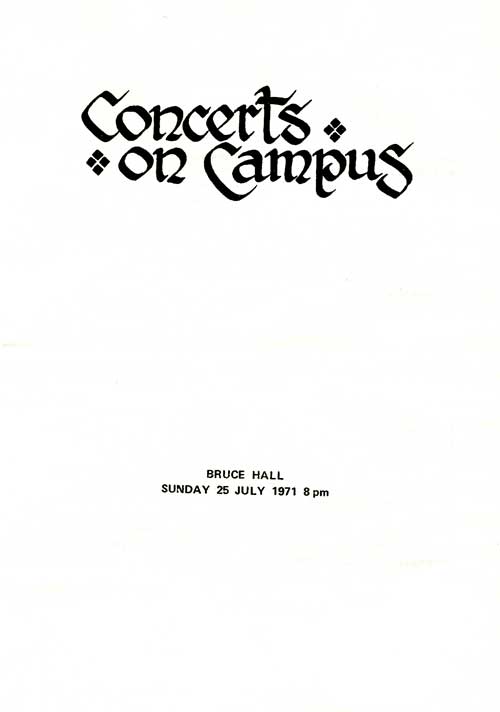

SCUNA history » Concerts » 1971 - Term 2
On this page: Advertisement | Programme
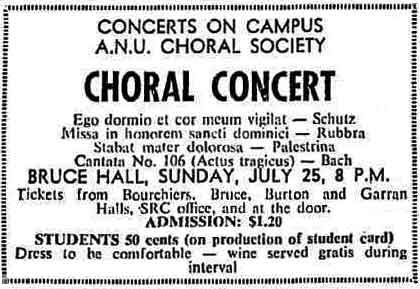
Ego dormio et cor meum vigilat - Schutz
Missa in honorem sancti dominici - Rubbra
Stabat mater dolorosa - Palestrina
Cantata No. 106 (Actus tragicus) - Bach
BRUCE HALL, SUNDAY, JULY 25, 8 P.M.
Tickets from Bourchiers, Bruce, Burton and Garran Halls, SRC office, and at the door.
ADMISSION: $1.20
STUDENTS 50 cents (on production of student card)
Dress to be comfortable - wine served gratis during interval
Source: Advertising. (1971, July 17). The Canberra Times (ACT : 1926 - 1995), p. 19. Retrieved May 31, 2013, from Trove: http://nla.gov.au/nla.news-article110668079
Also appeared on Saturday 24 July 1971, without the dress line, but with DIRECTOR: Ayis Ioannides above CHORAL CONCERT

Concerts on Campus
BRUCE HALL
SUNDAY 25 JULY 1971 8 pm
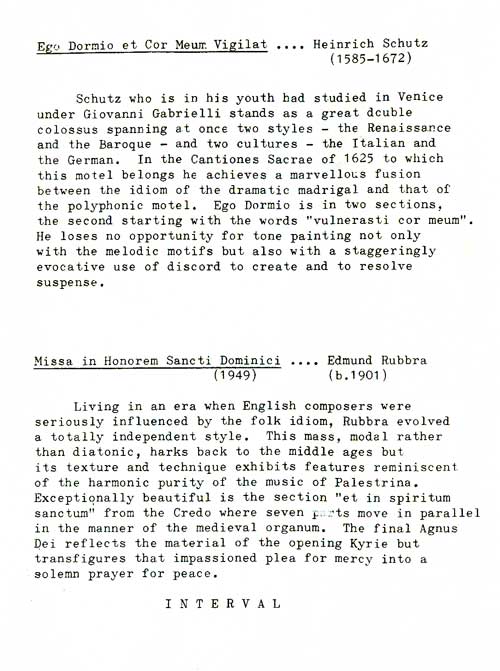
Ego Dormio et Cor Meum Vigilat .... Heinrich Schutz (1585-1672)
Schutz who in his youth had studied in Venice under Giovanni Gabrielli stands as a great double colossus spanning at once two styles -- the Renaissance and the Baroque -- and two cultures -- the Italian and the German. In the Cantiones Sacrae of 1625 to which this motel belongs he achieves a marvellous fusion between the idiom of the dramatic madrigal and that of the polyphonic motel. Ego Dormio is in two sections, the second starting with the words "vulnerasti cor meum". He loses no opportunity for tone painting not only with the melodic motifs but also with a staggeringly evocative use of discord to create and to resolve suspense.
Missa in Honorem Sancti Dominici (1949) .... Edmund Rubbra (b.1901)
Living in an era when English composers were seriously influenced by the folk idiom, Rubbra evolved a totally independent style. This mass, modal rather than diatonic, harks back to the middle ages but its texture and technique exhibits features reminiscent of the harmonic purity of the music of Palestrina. Exceptionally beautiful is the section "et in spiritum sanctum" from the Credo where seven parts move in parallel in the manner of the medieval organum. The final Agnus Dei reflects the material of the opening Kyrie but transfigures that impassioned plea for mercy into a solemn prayer for peace.
I N T E R V A L
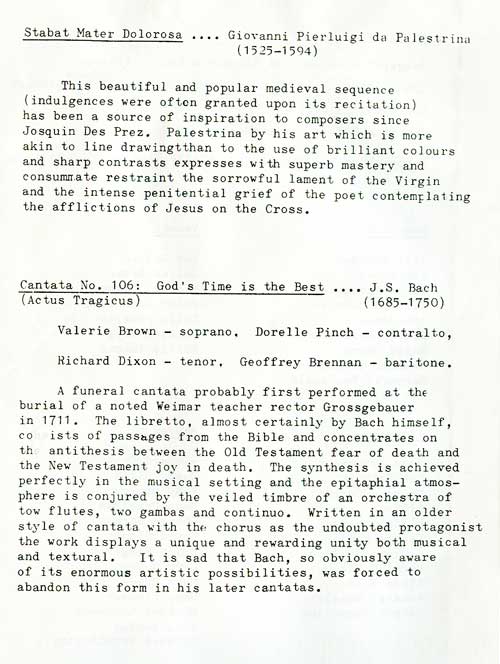
Stabat Mater Dolorosa* .... Giovanni Pierluigi da Palestrina (1525-1594)
This beautiful and popular medieval sequence (indulgences were often granted upon its recitation) has been a source of inspiration to composers since Josquin Des Prez. Palestrina by his art which is more akin to line drawing than to the use of brilliant colours and sharp contrasts expresses with superb mastery and consummate restraint the sorrowful lament of the Virgin and the intense penitential grief of the poet contemplating the afflictions of Jesus on the Cross.
Cantata No. 106: God's Time is the Best (Actus Tragicus) .... J.S. Bach (1685-1750)
Valerie Brown - soprano. Dorelle Pinch - contralto,
Richard Dixon - tenor. Geoffrey Brennan - baritone.
A funeral cantata probably first performed at the burial of a noted Weimar teacher rector Grossgebauer in 1711. The libretto, almost certainly by Bach himself, consists of passages from the Bible and concentrates on the antithesis between the Old Testament fear of death and the New Testament joy in death. The synthesis is achieved perfectly in the musical setting and the epitaphial atmosphere is conjured by the veiled timbre of an orchestra of two flutes, two gambas and continuo. Written in an older style of cantata with the chorus as the undoubted protagonist the work displays a unique and rewarding unity both musical and textural. It is sad that Bach, so obviously aware of its enormous artistic possibilities, was forced to abandon this form in his later cantatas.
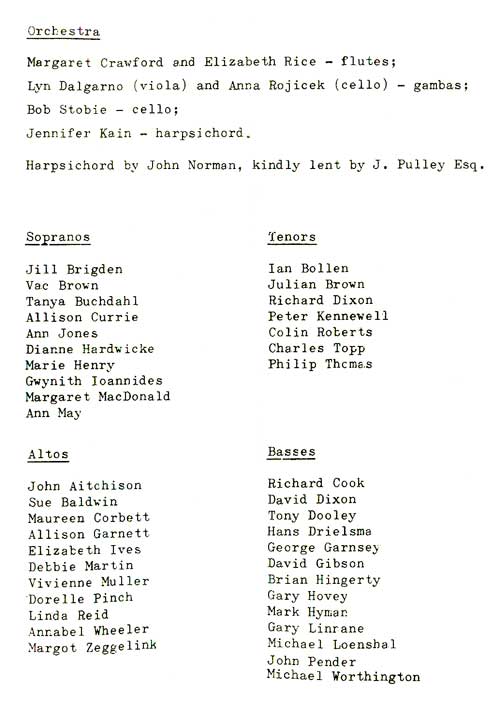
Orchestra
Margaret Crawford and Elizabeth Rice - flutes;
Lyn Dalgarno (viola) and Anna Rojicek (cello) - gambas;
Bob Stobie - cello;
Jennifer Kain - harpsichord.
Harpsichord by John Norman, kindly lent by J. Pulley Esq.
| Sopranos | Tenors |
| Jill Brigden Val Brown Tanya Buchdahl Allison Currie Ann Jones Dianne Hardwicke Marie Henry Gwyneth Ioannides Margaret MacDonald Ann May |
Ian Bollen Julian Brown Richard Dixon Peter Kennewell Colin Roberts Charles Topp Philip Thomas |
| Altos | Basses |
| John Aitchison Sue Baldwin Maureen Corbett Allison Garnett Elizabeth Ives Debbie Martin Vivienne Muller Dorelle Pinch Linda Reid Annabel Wheeler Margot Zeggelink |
Richard Cook David Dixon Tony Dooley Hans Drielsma George Garnsey David Gibson Brian Hingerty Gary Hovey Mark Hyman Gary Linnane Michael Loenshal John Pender Michael Worthington |
It is my recollection that the Small Group / Madrigal Group sang the Palestrina Stabat Mater.